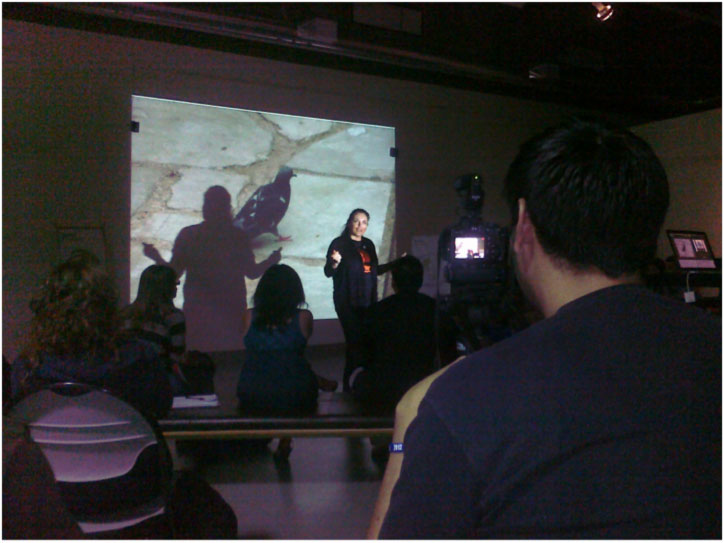Just change: media, stories, and actions
By Moushumi Biswas
EL PASO – It was a celebration of innovative minds at Just Story Hour at the Rubin Center for the Visual Arts, UTEP, on October 15. The theme for the bright and sunny early fall afternoon was “thinking to make a difference.” It was the signature bi-annual event of the Social Justice Initiative (SJI), which is housed in UTEP’s Department of Communication, held in conjunction with the YWCA’s Week without Violence and the Rubin Center’s exhibit, Shifting Sands: Recent Videos from the Middle East.

Lucia Durá speaks about nurturing habits of the eye to see the beauty of the pigeon. (Moushumi Biswas/Social Justice Initiative)
The SJI’s motto is “cultivating the habits of the heart” instead of the “habits of the mind” to break the status quo in conversations and actions about issues of justice, equity and peace. In accordance with its motto, the SJI invited guests who have created new approaches to tackle existing challenges. For instance, there was “mathemusician” Larry Lesser who composed songs to increase awareness and motivation in mathematics. Here is a line from one of his songs that shows how Lesser tries to make math interesting: “Find, find the value of pi – starts 3 point 1 4 1 5 9.” Lesser, a recipient of the University of Texas Regents’ Outstanding Teaching Award, enthralled the audience with a rendering of one of his songs.
Then there was Cemelli de Aztlan, Director of the Racial Justice program at the YWCA Paso del Norte, who performed a Native American healing song. In a world that depends more and more on synthetic drugs for cure of the body and the mind, it was obvious from the melodious notes of the age-old song how the spirit – and thereby the body –can be calmed through alternative ways.
From the art world, there was Pancho Sanchez who showed some of his digitized artwork on the screen. In addition, SJI members Arvind Singhal, Lucia Durá and Anu Sachdev spoke on the occasion, sharing their insights into approaches that make a difference. Singhal narrated the story of Mother Teresa who had once been asked to join a march “against war.” She declined, said Singhal, though she added she would be happy to take part in a demonstration “for peace.” This was an instance of thinking differently to see an issue in a positive and creative light and thus be able to break the status quo in the effort to find a solution.
Durá mentioned how her husband, Michael, had the gift of seeing beauty in unexpected places. For instance, he would find the ordinary pigeon to be an extraordinarily beautiful bird. “It was only when I looked back at my childhood, and recalled how my mother would always say the pigeon is ugly, that I realized my eyes and heart were closed to the beauty of the pigeon,” mused Durá.
Sachdev, a Teaching Assistant in the Department of Communication, referred to the “Candle Problem,” which addresses the “functional fixedness” of the mind, and challenged people to find out for themselves how to make a candle stand against the wall without spilling wax. People are allowed to have a matchbox and board pins in addition to the candle. After teasing the audience’s minds for half a minute, Sachdev finally suggested that they try to fix the matchbox to the wall with the help of board pins and make the candle stand on top of it.
This fall semester’s Just Story Hour ended on a thoughtful note, urging people to think creatively and out of the “matchbox”, as it were, to keep making a difference.


